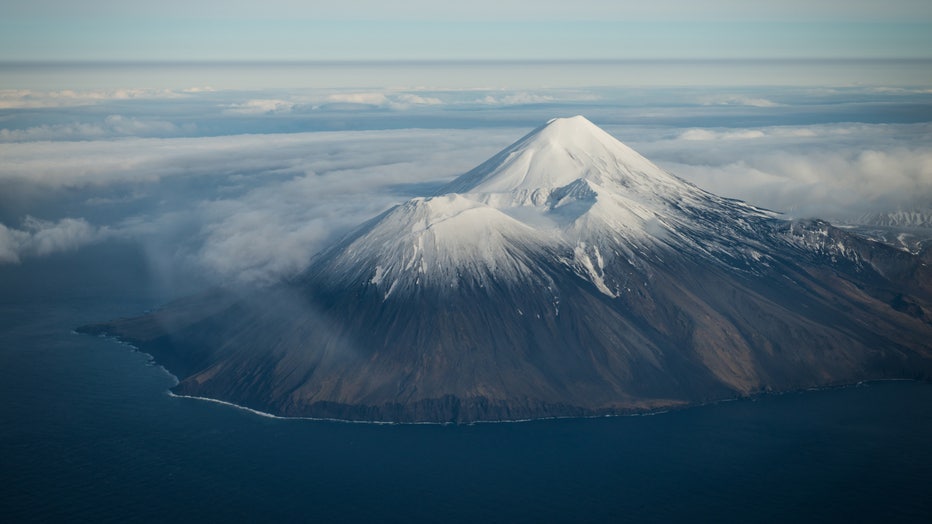Earthquake swarms at two Alaska volcanoes raise fears of possible eruption
Not one but two volcanoes on the same island in Alaska’s Aleutian chain were rocked by earthquakes on Friday, prompting concerns about a possible eruption.
Elevated earthquake activity was reported at both Tanaga and Takawangha volcanoes on uninhabited Tanaga Island, hundreds of miles (kilometers) from Anchorage.
"If an eruption were to occur, it is uncertain at this stage if it would come from Takawangha or Tanaga," officials at the Alaska Volcano Observatory said in a statement that raised the alert level for the two volcanoes.
What's the latest?
Even though the frequency of tremors slightly diminished Friday, earthquake activity at the volcanoes was still occurring about every minute or two.

Tanaga, in November 2012. Photograph courtesy of Roger Clifford.
"We’re still getting earthquakes up above magnitude 3 going on quite regularly," said John Power, a research geophysicist with the U.S. Geological Survey stationed at the Alaska Volcano Observatory in Anchorage.
Seismic activity ramped up earlier this week at Tanaga Volcano, the middle of three volcanoes on Tanaga Island, located about 1,250 miles (2,012 kilometers) southwest of Anchorage, the state’s major population area.
Then mid-week, earthquake activity began to intensify at Takawangha, a volcano about 5 miles (8 kilometers) to the east of Tanaga.
READ MORE: Alaska volcano dormant for a century delivering ominous warning signs: 'Significant unrest'
"We’ve seen actually earthquake activity building beneath both epicenters and in between them, which is causing us quite a bit of concern about what’s going on," Power said. "It’s a very energetic sequence."
A third volcano on the island, Sajaka, about 2 miles (3 kilometers) to the west of Tanaga, is not showing any sign of activity.
What's the biggest threat?
Since the island is uninhabited, the thick, viscous lava that could flow in an eruption would not cause harm. The nearest community, Adak, is about 65 miles (104 kilometers) to the east, on a separate island.
However, an ash cloud could pose threats to aircraft, potentially disrupting air travel between North America and Asia, and health problems for communities farther away. Volcanic ash is angular and sharp and has been used as an industrial abrasive. The powdered rock can cause a jet engine to shut down.
An interagency volcanic ash response plan, developed in 2011, details how state, federal and local agencies should respond to a volcanic eruption in the region that can cast ash throughout the area. It calls for the Alaska Volcano Observatory to take the lead in confirming an eruption and notify other agencies, which would then alert pilots, mariners and local communities.
Where and how far any ash would go would depend on numerous factors. Fine ash drifting to cities can cause respiratory problems for people and animals, interfere with electrical equipment and damage air filters and gasoline engines.
Does earthquake activity always mean impending eruption?
The short answer is no.
Both Takawangha and Tanaga volcanoes in 2005 had smaller earthquake swarms that eventually just dissipated without an eruption — at least none that officials know about.
"We did see some signals that might have been very minor eruptive activity, but we were never able to confirm that," Power said.
Some of the areas active in 2005 are where scientists are seeing a lot of earthquake activity now. "Where and how this activity will come to an end, whether or not it will lead to an eruption is an open question," Power said.
How unusual is it for two active volcanoes to be close together?
Having two volcanoes this close and both in a state of unrest is very unusual in Alaska, Power said, even though there are such occurrences elsewhere in the world.
For example, Mauna Loa and Kilauea both were erupting at the same time last year on Hawaii’s Big Island.
"It is unusual that ... we’re seeing earthquakes under both centers at the same time and actually between the centers, something which suggests to us that there’s probably something larger afoot here in the subsurface, the magma and so on beneath the volcanoes," Power said.

